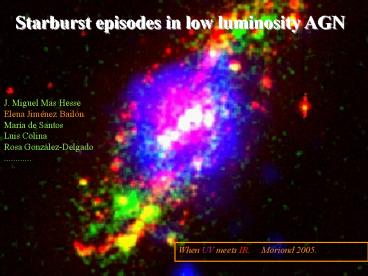Presentacin de PowerPoint PowerPoint PPT Presentation
Title: Presentacin de PowerPoint
1
Starburst episodes in low luminosity AGN
J. Miguel Mas Hesse Elena Jiménez Bailón María
de Santos Luis Colina Rosa González-Delgado
............
When UV meets IR. Moriond 2005.
2
Strategy
- The active nucleus in Seyfert 2 (and by
extension other low luminosity AGN) seems to
be (partially) hidden by dense material. - Obscuration of the AGN should be maximum in the
UV. - It is known (see previous talk by Elena
Terlevich) that Seyfert 2 galaxies host intense
star formation regions very close to the
nucleus. - The starburst emission peaks in the UV.
- ? The UV continuum of low luminisoity AGN should
be dominated by the (circum-) nuclear
starbursts.
3
Strategy
- We are analyzing a sample of low luminosity AGN
aiming to disentangle the relative
contributions of both the starburst and the
active nucleus - i.- We characterize the young, massive stellar
population from the analysis of the UV
continuum. - ii.- With evolutionary synthesis models we
compute the contributions at different
wavelengths expected from the starburst. - iii.- Comparison with observations allows to
derive the relative weight of both
processes.
4
The Sample
5
HST-STIS (2200 Å) 1.5x1.5 kpc2
NGC 4303
D 16.1 Mpc ? 1? ? 78 pc
Very compact nuclear source, surrounded by
circumnuclear spiral armsdominated by massive
stars within a radius of 300 pc.
6
- The central, compact source (3 pc in diameter)
is dominated in the UV by a very young Super
Stellar Cluster of massive stars - - 4 Myr
- - 105 M?
- - E(B-V) 0.1
7
The optical and NIR, on the other hand, are
dominated by the extended bulge population,
with an estimated age of 1 Gyr
8
Chandra allows to separate the X-ray emission
from the nucleus and the star-forming ring
9
NGC 4303 Nuclear region
2 components - power law - thermal plasma
(Raymond Smith) ? 1.6?0.3 (F? ?? ? ?
?1) kT 0.650.24-0.17 keV, T 83-2 106 K
10
NGC 4303 Annular region, r 140-615 pc
2 components - thermal plasma at 2
temperatures kT1 0.310.6-0.05 keV, T
4.60.7-0.6106 K kT2 0.80.1-0.2 keV, T
91-2106 K NH 5?3?1021 at/cm2
11
- Evolutionary synthesis models (Cerviño,
Mas-Hesse Kunth) reproduce the total soft
hard X-ray emission of the circumnuclear
star-forming regions. - The CMHK models also reproduce the soft, thermal
X-ray emission from the nucleus, associated
to the SSC. - But, in addition to the SSC, there is a hard
X-ray source in the nucleus, with L2-10keV
1039 erg/s AGN or
Ultraluminous X-ray source (ULX)?
12
NGC 1808
D 10.9 Mpc ? 1? ? 53 pc
XMM-OM (2200 Å) 11x15 kpc2
13
NGC 1808
X-rays ? BLUE UV emission ? GREEN H?
emission ? RED
14
NGC 1808 Nuclear region, r 850 pc
2 components - power law - thermal plasma
(Mekal) ? 0.86?0.07 kT 0.580.02-0.07 keV,
T 6.60.2-0.6106 K Ne1.50.9-0.6
Mg2.00.9-0.6 Si1.60.9-0.6
Fe0.60.2-0.1
15
- The soft X-ray emission is mostly contributed by
the massive clusters in the nuclear region
(106 M?). - The Star Formation Rates derived from both the
soft X-ray and the IRAS Far Infrared
luminosities are very consistent 3.5 vs 4.0
M? /yr - But, in addition to the SSC, there is again a
hard X-ray source in the nucleus, with
L2-10keV 1040 erg/s. AGN or ULX?
16
NGC 1068
D 14.4 Mpc ? 1? ? 72 pc
There is a very compactand bright source within
30 pc around the nucleus.
HST-FOC 0.3x0.3 kpc2
UV continuum (2200 Å)
17
- The emission from the hot spot has been
historically assumed to be nuclear reflected
light. - But the efficiency of reflection is
- very low, and the polarization
- degree of the UV - optical
- continuum is below 20.
- Indeed, a young stellar population provides
a better fit to UV - NIR continuum.
18
- 5.4 Myr - 2?106 M? - E(B-V) 0.08
19
(No Transcript)
20
- Although a massive SSC might be present within
30 pc of the NGC 1068 nucleus, contributing
to most of the observed UV continuun, the
energetics in the other ranges is dominated
by the active source - The contribution to soft X-rays might be
non-negligible, but is is any case below
30. The contribution to hard X-rays is
negligible. The SSC could produce only around
1/50 of the ionizing photons producing the
observed emission line spectrum, and no more
than 1/10 of the observed FIR luminosity.
21
NGC 1068 A different view
22
Conclusions
- Violent star formation episodes can take place
very close to the nuclei of some AGN. - While the energetics of NGC 1068 (Seyfert 2)
seems to be dominated by the AGN (except
might be in the UV), the starburst is the
dominating energy source in the other objects. - The AGN nature of these galaxies seems to be
linked to their hard X-ray excesses, but their
X-ray luminosity is compatible with
individual sources, like ULX, of yet unknown
origin. - Maybe a significant fraction of low luminosity
AGN are indeed just powerful starbursts
having developed bright hard X-ray emitters,
mimicking the ionizing properties of active
nuclei!

